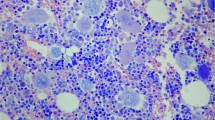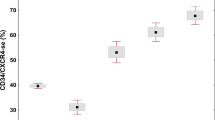Abstract
A clinicopathological follow-up study including sequential bone marrow biopsies was performed on 79 patients with idiopathic (primary) myelofibrosis (IMF) to characterize initial (prefibrotic) stages and to elucidate whether development of fibrosis was accompanied by corresponding clinical findings. For this purpose our cohort of patients was divided into two groups of which the first presented with the generally accepted signs and symptoms of IMF (group I; n = 60). Most patients of the second group (group II; n = 19) showed mild to moderate therapy-refractory anemia, minimal to slight splenomegaly and frequently thrombocytosis, but no bone marrow fibrosis at onset. Hematopoiesis was consistent with a striking hypercellularity in comparison to the age-related involution by adipose tissue, a conspicuous clustering and histotopographic dislocation of megakaryocytes, a neutrophil granulocytic proliferation and a reduction of erythropoietic islets with arrest of maturation. Most remarkable was the dysplastic cytology of megakaryocytes with a definitive deviation of differentiation resulting in bizarre forms. Follow-up examinations revealed that at later stages group II patients were not distinguishable from the first group with more advanced IMF. For this reason, these patients were regarded as presenting initial, prefibrotic IMF characterized by distinctive bone marrow features at the beginning. The prominent abnormalities of megakaryopoiesis together with the granulocytic proliferation were extremely helpful to differentiate prefibrotic IMF with accompanying thrombocythemia from essential thrombocythemia (ET). Dynamics of fiber progression were calculated by regarding increase in density per time. Speed of progression during the first year of observation proved to be significantly higher in group II patients with prefibrotic IMF in comparison to full-blown cases (group I). In conclusion, with respect to prospective clinical trials, diagnostic criteria for IMF should be re-evaluated by also taking initial, prefibrotic stages into account.
This is a preview of subscription content, access via your institution
Access options
Subscribe to this journal
Receive 12 print issues and online access
$259.00 per year
only $21.58 per issue
Buy this article
- Purchase on Springer Link
- Instant access to full article PDF
Prices may be subject to local taxes which are calculated during checkout
Similar content being viewed by others
Author information
Authors and Affiliations
Rights and permissions
About this article
Cite this article
Thiele, J., Kvasnicka, H., Boeltken, B. et al. Initial (prefibrotic) stages of idiopathic (primary) myelofibrosis (IMF) – a clinicopathological study. Leukemia 13, 1741–1748 (1999). https://doi.org/10.1038/sj.leu.2401553
Received:
Accepted:
Published:
Issue Date:
DOI: https://doi.org/10.1038/sj.leu.2401553
Keywords
This article is cited by
-
Different number of circulating CD34 + cells in essential thrombocythemia, prefibrotic/early primary myelofibrosis, and overt primary myelofibrosis
Annals of Hematology (2022)
-
Prefibrotic myelofibrosis: treatment algorithm 2018
Blood Cancer Journal (2018)
-
The 2016 WHO classification and diagnostic criteria for myeloproliferative neoplasms: document summary and in-depth discussion
Blood Cancer Journal (2018)
-
Clinical impact of bone marrow morphology for the diagnosis of essential thrombocythemia: comparison between the BCSH and the WHO criteria
Leukemia (2016)
-
Reproducibility of the WHO histological criteria for the diagnosis of Philadelphia chromosome-negative myeloproliferative neoplasms
Modern Pathology (2014)



